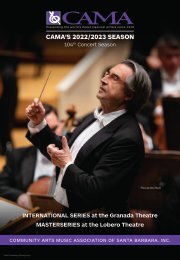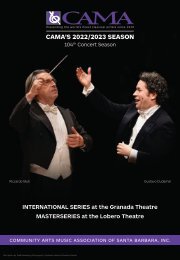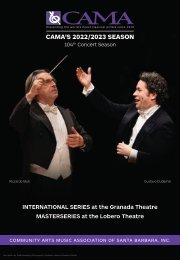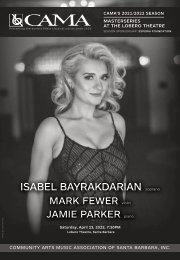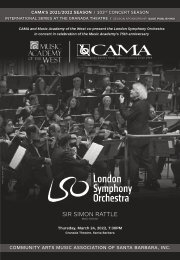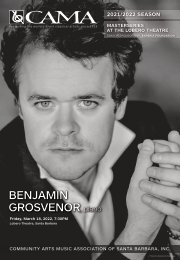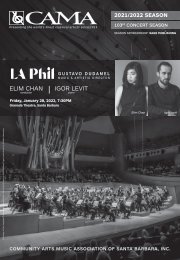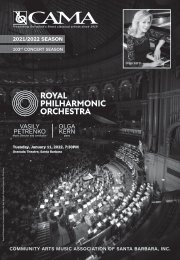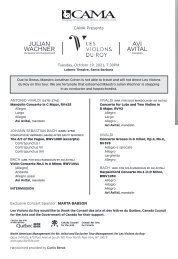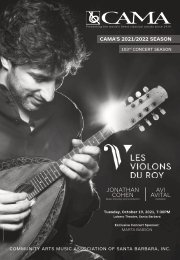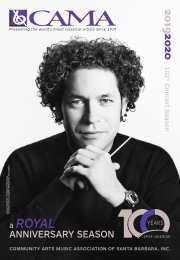Philharmonia Baroque Orchestra—February 5, 2019—CAMA's International Series at The Granada Theatre—Centennial Season
TUESDAY, FEBRUARY 5, 2019, 8:00 PM Philharmonia Baroque Orchestra Nicholas McGegan, Music Director Rachel Barton Pine, violin Renowned as an interpreter of a wide range of classical music, English-born conductor Nicholas McGegan was appointed Officer of the Most Excellent Order of the British Empire (OBE) for “services to music overseas” by Queen Elizabeth in 2010. He has served since 1985 as Music Director of the Philharmonia Baroque Orchestra, establishing it as the leading period performance ensemble in the United States. The Philharmonia is dedicated to capturing the spirit and distinctive sound of music from the Baroque to the early Romantic periods using authentic instruments and stylistic conventions. American violinist Rachel Barton Pine, the youngest-ever gold medal winner of the International Johann Sebastian Bach Competition, will join the orchestra for the rarely performed Violin Concerto in D major of violinist Franz Clement (one of Beethoven’s closest friends, for whom he composed his own Violin Concerto in D major). PROGRAM: Wolfgang Amadeus Mozart: Overture to The Marriage of Figaro, K.492 Franz Clement: Violin Concerto in D Major (1805) Franz Schubert: Symphony No.6 in C Major, D.589 PRE-CONCERT LECTURE BY ANDY RADFORD, MUSIC DIRECTOR, SANTA BARBARA YOUTH SYMPHONY; AND LECTURER, WOODWIND, BRASS & PERCUSSION PROGRAM, UCSB DEPARTMENT OF MUSIC Lecture will begin at 7:00 PM; doors to The Granada Theatre will open for the lecture at 6:45 PM. Lecture seating is limited to the first 100 patrons. First come, first served. #CAMASB #CAMAat100 #CAMACentennial
TUESDAY, FEBRUARY 5, 2019, 8:00 PM
Philharmonia Baroque Orchestra
Nicholas McGegan, Music Director
Rachel Barton Pine, violin
Renowned as an interpreter of a wide range of classical music, English-born conductor Nicholas McGegan was appointed Officer of the Most Excellent Order of the British Empire (OBE) for “services to music overseas” by Queen Elizabeth in 2010. He has served since 1985 as Music Director of the Philharmonia Baroque Orchestra, establishing it as the leading period performance ensemble in the United States. The Philharmonia is dedicated to capturing the spirit and distinctive sound of music from the Baroque to the early Romantic periods using authentic instruments and stylistic conventions. American violinist Rachel Barton Pine, the youngest-ever gold medal winner of the International Johann Sebastian Bach Competition, will join the orchestra for the rarely performed Violin Concerto in D major of violinist Franz Clement (one of Beethoven’s closest friends, for whom he composed his own Violin Concerto in D major).
PROGRAM:
Wolfgang Amadeus Mozart: Overture to The Marriage of Figaro, K.492
Franz Clement: Violin Concerto in D Major (1805)
Franz Schubert: Symphony No.6 in C Major, D.589
PRE-CONCERT LECTURE BY ANDY RADFORD, MUSIC DIRECTOR, SANTA BARBARA YOUTH SYMPHONY; AND LECTURER, WOODWIND, BRASS & PERCUSSION PROGRAM, UCSB DEPARTMENT OF MUSIC
Lecture will begin at 7:00 PM; doors to The Granada Theatre will open for the lecture at 6:45 PM.
Lecture seating is limited to the first 100 patrons. First come, first served.
#CAMASB #CAMAat100 #CAMACentennial
You also want an ePaper? Increase the reach of your titles
YUMPU automatically turns print PDFs into web optimized ePapers that Google loves.
Unlike the holy trinity of Classicism—<br />
Haydn, Mozart, and Beethoven—both Schubert<br />
and Clement were actual n<strong>at</strong>ive Viennese.<br />
<strong>The</strong>re was personal contact between Haydn<br />
and Mozart, Haydn and Beethoven, and<br />
Beethoven and Clement, but more important<br />
was the cross-pollin<strong>at</strong>ion of musical influences<br />
taking place in Vienna’s schools, concert<br />
halls, and salons. Though the presence of<br />
Beethoven looms large over Schubert’s<br />
music, there is only circumstantial evidence to<br />
suggest th<strong>at</strong> they ever met. Young Schubert<br />
played early Beethoven symphonies in his<br />
school orchestra, and was keenly aware of<br />
Beethoven’s towering presence. “I really hope<br />
to be able to make something of myself, but<br />
who can do anything now after Beethoven?”<br />
he complained.<br />
Lorenzo da Ponte (the other two were Don<br />
Giovanni and Così fan tutte) the Figaro overture<br />
is the only one th<strong>at</strong> does not explicitly preview<br />
themes to be heard in the opera. R<strong>at</strong>her it<br />
bubbles up hesitantly before rushing headlong<br />
into activity th<strong>at</strong> doesn’t stop until the final<br />
cadence. Cascading scales, vigorous repe<strong>at</strong>ed<br />
notes, mounting crescendos, occasional<br />
fanfares, and sharp accents ramp up energy<br />
which is unrelieved by any conventionally<br />
lyrical “second theme.” Since he left the<br />
overture until last, Mozart certainly had the<br />
themes of the opera in his head and could<br />
easily—even more easily—employed them.<br />
But since the opera itself opens in medias res,<br />
with the amorous advances of a philandering<br />
Count having already been rebuffed <strong>at</strong> least<br />
once by his wife’s wily maid, perhaps we<br />
should think of this overture as a depiction of<br />
the frenetic activities of the characters taking<br />
place before the curtain rises.<br />
in the eighteenth and nineteenth centuries.<br />
Beethoven's violin concerto was therefore<br />
not composed <strong>at</strong> the behest of one of his noble<br />
supporters (of which he had many), but instead<br />
was designed to showcase the talents of its<br />
performer. Beethoven left room for cadenzas<br />
in the two outer movements, plus he calls for<br />
a cadenza to connect the second and third<br />
movements. Clement was given a free hand<br />
for these cadenzas, receiving no instruction<br />
from Beethoven. <strong>The</strong> composer never wrote<br />
(and therefore never published) his own violin<br />
cadenzas for the piece, and Clement's cadenzas<br />
have not survived. (Note: All cadenzas you will<br />
hear <strong>at</strong> these performances were written by<br />
Alana Youssefian herself.) Still, the influence of<br />
the popular performer can be felt strongly in<br />
the other solo sections—his admirers primarily<br />
praised his expressive and elegant sound,<br />
which Beethoven exploited <strong>at</strong> various points in<br />
the piece. Yet Clement was not above certain<br />
lead to weariness." However, the sense of organic<br />
unity cre<strong>at</strong>ed in his compositions would<br />
soon be prized by romantics. <strong>The</strong> timpani introduces<br />
the most distinctive motive of the<br />
concerto's opening Allegro movement. It consists<br />
of five repe<strong>at</strong>ed quarter notes followed<br />
by rests, or silence. According to Andreas<br />
Moser, a l<strong>at</strong>e nineteenth-century violinist and<br />
historian, this motive has intriguing origins:<br />
MOZART:<br />
Overture to <strong>The</strong> Marriage<br />
of Figaro<br />
Receiving their parts only two days before the<br />
opening of Le Nozze di Figaro <strong>at</strong> Vienna’s court<br />
the<strong>at</strong>er on May 1, 1786, Mozart’s orchestra<br />
must have been dumbstruck by the nonstop<br />
profusion of sixteenth notes th<strong>at</strong> blackened<br />
their pages. <strong>The</strong> first of the “big three” operas<br />
composed in collabor<strong>at</strong>ion with librettist<br />
BEETHOVEN:<br />
Concerto for Violin in D Major,<br />
Op.61<br />
Beethoven composed his only complete<br />
violin concerto for Franz Clement, a<br />
renowned performer who also conducted<br />
the orchestra <strong>at</strong> the <strong>The</strong><strong>at</strong>er an der Wien in<br />
Vienna. Beethoven completed the work in<br />
only a few weeks, and many contemporaries<br />
reported th<strong>at</strong> Clement had to play it virtually<br />
<strong>at</strong> sight, although some evidence suggests<br />
th<strong>at</strong> he may have advised Beethoven as<br />
the concerto took shape. <strong>The</strong> premiere<br />
took place on December 23, 1806, <strong>at</strong> a<br />
benefit concert for Clement himself—such<br />
public concerts, given by self-supporting<br />
musicians, were common throughout Europe<br />
stage antics: <strong>at</strong> the concerto's premiere he<br />
even played a short piece of his own in between<br />
the first and second movements, while holding<br />
his violin upside down, perhaps for some comic<br />
relief.<br />
Beethoven wrote the concerto following<br />
the composition of his groundbreaking Eroica<br />
Symphony (1803), and while he was working<br />
on both the Fourth and Fifth Symphonies. It<br />
shares a number of fe<strong>at</strong>ures with these symphonic<br />
works. <strong>The</strong> opening movement—like<br />
th<strong>at</strong> of the Eroica—is quite expansive, and<br />
Beethoven cre<strong>at</strong>es a sense of unity by working<br />
out a short rhythmic motive, a technique for<br />
which he became famous—but one which did<br />
not win the immedi<strong>at</strong>e favor of audiences. One<br />
review even noted th<strong>at</strong> "the endless repetitions<br />
of a few commonplace passages could easily<br />
[It] is said to have occurred to Beethoven<br />
during the stillness of a sleepless night, on<br />
hearing someone knocking <strong>at</strong> the door of a<br />
neighboring house. <strong>The</strong> knocking consisted<br />
always of five regular blows in succession, repe<strong>at</strong>ed<br />
after a pause; and Beethoven, overjoyed<br />
<strong>at</strong> being able to distinguish the sound so<br />
clearly, for <strong>at</strong> this time his hearing was beginning<br />
to be seriously impaired, used it as the<br />
opening theme for the violin concerto.<br />
Though it bears some similarities to the<br />
famous opening motive of the Fifth Symphony,<br />
which Beethoven reportedly described as<br />
"f<strong>at</strong>e knocking <strong>at</strong> the door," the opening motive<br />
of the violin concerto is less ominous. Distinctive<br />
and easily recognizable to the listener,<br />
its various manipul<strong>at</strong>ions call <strong>at</strong>tention to<br />
Beethoven's compositional skills. It maintains<br />
12 CENTENNIAL SEASON CELEBRATION CAMA AT THE GRANADA THEATRE - PHILHARMONIA BAROQUE ORCHESTRA 13




